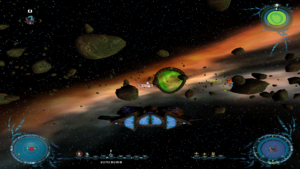Sinistar Unleashed
 Frustrated by my lack of progress in Galaga: Destination Earth, I try another, similar game from the Stack: Sinistar Unleashed, a 3D reimagining of an arcade game famous for being frustratingly difficult. This might seem like a strange choice under the circumstances, but (A) Sinistar Unleashed is significantly different from the original Sinistar and (B) I never really understood why Sinistar had that reputation in the first place. I’ve mentioned this before. It’s not that I found Sinistar easy, mind you. It’s just that I didn’t find it significantly harder than most other arcade games. For a quarter, I could get a solid few minutes of gameplay, in which I would finish the first level and sometimes the second. Looking around at retrogaming forums while trying to shore up my knowledge of the mechanics, it seems like the people who complain about it simply have a different perspective than me. They expect that, with enough practice, they should be able to completely master a game, to the point where they can play it indefinitely. And Sinistar simply never let them do that.
Frustrated by my lack of progress in Galaga: Destination Earth, I try another, similar game from the Stack: Sinistar Unleashed, a 3D reimagining of an arcade game famous for being frustratingly difficult. This might seem like a strange choice under the circumstances, but (A) Sinistar Unleashed is significantly different from the original Sinistar and (B) I never really understood why Sinistar had that reputation in the first place. I’ve mentioned this before. It’s not that I found Sinistar easy, mind you. It’s just that I didn’t find it significantly harder than most other arcade games. For a quarter, I could get a solid few minutes of gameplay, in which I would finish the first level and sometimes the second. Looking around at retrogaming forums while trying to shore up my knowledge of the mechanics, it seems like the people who complain about it simply have a different perspective than me. They expect that, with enough practice, they should be able to completely master a game, to the point where they can play it indefinitely. And Sinistar simply never let them do that.
But, as I say, Sinistar Unleashed is a different game. Completely mastering this game doesn’t mean playing indefinitely. It means beating level 24. And it doesn’t even expect you to do it in a single go, like G:DE does: it’s possible to make permanent progress. According to the manual, “If you’ve successfully completed the bonus level of a zone in a previous game, you can skip that zone when starting a new game”. What’s a “zone”? Apparently it’s four levels, matching the cycles of the original game. But I haven’t yet gotten beyond level 3, so I’m still in the position of starting each game from the very beginning.
Where the other remakes I’ve been playing hew pretty close to the visual style of the originals, SU heads off in its own direction, more Psygnosis-y in its sense of cool. Enemies are sort of biomechanical and crustacean-like, including the Sinistars themselves. In the original, the Sinistar was a big metal demon head, and kind of goofy in a way that doesn’t fit here — although something similar does show up on the Game Over screen, suggesting that it might be the final boss. Here, there seems to be a different Sinistar on every level, and every one that I’ve seen looks like some horrible mutated sea creature. Even the player’s ship, although less crablike, is kind of organic-looking, with a veiny texture that changes color as you take damage.
I suppose it can get away with altering the visual style because so much because the Sinistar identity has so much more to do with the gameplay. There really wasn’t anything else like it at the arcades. It was a space shooter, sure, but it was one that gave the player an unusual amount of freedom to prioritize. An enemy fleet is building the Sinistar, a big scary battlestation which is only vulnerable to bombs made from crystals that you can shoot-mine from space rocks. But the same crystals are exactly what the enemies need to build the Sinistar. So you’re competing with them for resources, and can slow them down by destroying the workers, but this distracts you from your own crystal-collection efforts — as do the warrior ships hunting you down. It’s the sort of thing you more often see in RTS games than shooters, and it survives mostly intact in SU.
The biggest changes at that level of abstraction are these: In SU, the Sinistar is a lot more dangerous, and you can’t carry enough crystals at a time to destroy it completely, but you can damage it in advance by throwing bombs at it while it’s still under construction. The in-fiction justification for this is that the thing the workers are building isn’t actually the Sinistar itself, but the dimensional gate that allows it to enter your sector of space. Damaging the gate delays its completion and forces the Sinistar to spend longer in hyperspace, which is inherently damaging to it. If you do enough damage, you can even destroy the gate before the Sinistar appears. I myself have managed this exactly once so far.
 Comments(0)
Comments(0)